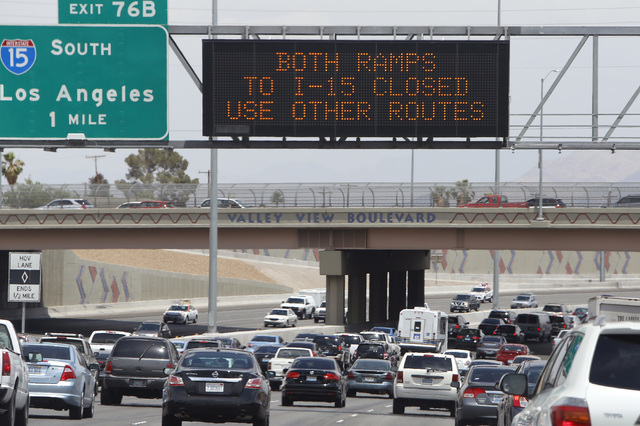Vegas quake gridlock tips: Be patient, pay attention

Mrs. Warrior and I were watching television coverage of the May 22 junior earthquake near Caliente, lamenting the lengths Hollywood went to promote the release of its disaster film, “San Andreas,” by making the earth move.
The aerial video of traffic backing up on southbound U.S. Highway 95 shook me up more than the earthquake itself.
As the freeway steadily turned into a parking lot, there were motorists who broke the ranks, maneuvered a U-turn and made their way to the nearest freeway exit. In some cases, cars were exiting on entrance ramps.
The reason for suddenly bolting off the freeway was that the exit ramp from southbound U.S. 95 to southbound Interstate 15 was closed by the Nevada Highway Patrol because troopers saw what looked like a widened gap in a freeway joint. Out of an abundance of caution, they opted for closure.
The Nevada Department of Transportation concurred and put out calls to their seismic experts to have a look — not an easy task on a Friday afternoon before the three-day Memorial Day weekend.
Usually when police close a section of highway for an emergency, they have an orderly plan of blocking freeway entrances or forcing traffic off exits to keep vehicles from getting stuck.
But inevitably, some motorists get through, especially immediately after an accident or unusual emergency incident. When the earthquake occurred and the ramp was closed, the freeway was filling with motorists going places during their lunch hour. Many of them didn’t get far before the gridlock took hold.
So what do you do in a circumstance like that? Sit and wait? Develop an unorthodox and illegal exit strategy? Weep uncontrollably?
Trooper Loy Hixon said it’s one of the most difficult situations to manage for a number of reasons.
“You simply can’t predict when there’s going to be some kind of emergency or a collision, or debris suddenly appears on the roadway in front of you,” he said. “But when something like this happens, the best thing to do is to be patient and pay attention. You don’t want to become a part of the problem, and if you start trying to find your own way off the highway, you put yourself and others at risk.”
Hixon acknowledged that especially in the summer months it’s not good to be stuck on the freeway. The sun’s heat can become dangerous for youngsters and the elderly. Car engines overheat. Tempers flare. Information is precious. Hixon suggested that motorists can get information by tuning in to radio broadcasts that monitor traffic.
Although he didn’t want to give the impression that it’s all right to do it regularly, Hixon said in cases when cars are gridlocked, it’s all right to go to the smartphone for information. The best way to do that: Have a passenger in the car search for local information. Hixon suggested that passengers can be part of the solution by tweeting information about the situation.
Then, just ride it out.
Traffic jams are never any fun, and they’re worse when they occur on a gridlocked highway. But staying patient and following the rules is the best way to avoid a worse calamity.
ABOUT THOSE HOV LANES …
A few weeks back, Warrior reader John asked whether he could drive his Nissan Leaf solo in the high-occupancy vehicle lanes because it’s recognized as an energy-efficient vehicle.
Trooper Hixon said he could, knowing that Nevada Revised Statutes reference federal regulations giving conditional approval of that.
When Hixon’s response was published, a few readers emailed me, saying they didn’t think that was right. And they are correct.
Approval of usage of high-occupancy lanes by energy-efficient vehicles requires an OK from state transportation officials. That hasn’t occurred in Nevada.
Nevada Revised Statute 484A addresses who can use high-occupancy lanes, and after listing vehicles with more than one occupant, motorcycles and buses, there’s a catch-all provision for “any other vehicle designated by regulation,” and that’s where the Nevada Department of Transportation comes in.
It’s not extremely important right now because there are only about 17 miles of HOV lanes in Clark County. But that will change in the years ahead as Project Neon unfolds and more HOV lanes are developed.
SLOW ROAD TO UTAH
If you’re planning to travel north on Interstate 15 through Arizona to Utah or south from St. George, Utah, to Mesquite in the next few days, brace for a slow go.
The Arizona Department of Transportation has announced that speed limits will be reduced to 25 mph, and it will take an extra hour to get through the Virgin River Gorge from 8 p.m. Monday through 8 p.m. Wednesday, as crews pour concrete for a new bridge deck.
It’s part of a multiyear rehab of one of the most beautiful stretches of interstate highway in the country.
Questions and comments should be sent to roadwarrior@reviewjournal.com. Please include your phone number. Find the Road Warrior on Twitter: @RJroadwarrior.